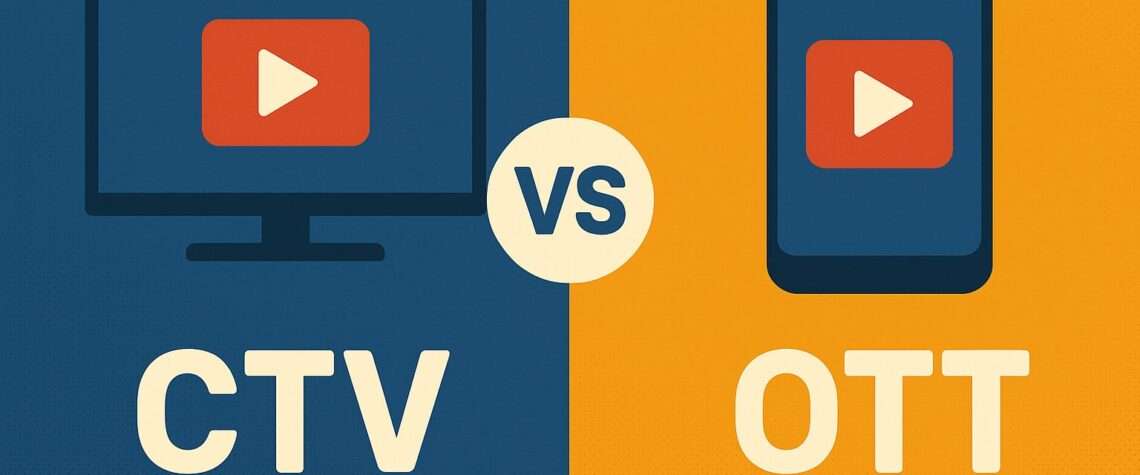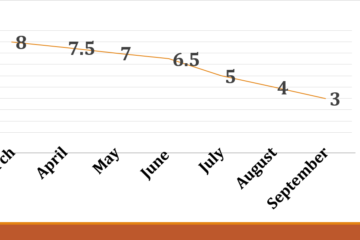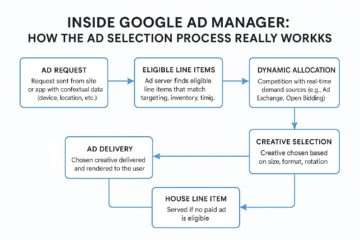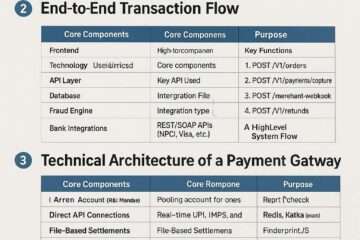

In the rapidly evolving world of digital media, terms like Connected TV (CTV) and Over-The-Top (OTT) are often thrown around, sometimes interchangeably. However, they represent distinct concepts within the streaming ecosystem. For marketers, content creators, advertisers, and even casual viewers, understanding the differences between CTV and OTT is crucial for navigating this landscape effectively. This article breaks down the major differences between CTV and OTT, with examples, characteristics, and their implications for the media industry.
Defining the Basics: What Are CTV and OTT?
What is CTV?
Connected TV (CTV) refers to the device—a television that is connected to the internet, either through built-in smart TV capabilities or via external devices like Roku, Amazon Fire Stick, Apple TV, or gaming consoles (e.g., PlayStation or Xbox). CTV is essentially the hardware that enables streaming content on a television screen, offering a big-screen, lean-back viewing experience.
Example: Watching a movie on Netflix using a Samsung Smart TV or streaming YouTube via a Chromecast plugged into your TV are both CTV experiences. The focus here is on the TV as the medium of consumption.
What is OTT?
Over-The-Top (OTT) refers to the content delivery method—media that is streamed directly to viewers over the internet, bypassing traditional cable or satellite providers. OTT encompasses the services and platforms that deliver content, such as Netflix, Hulu, or Disney+, and can be accessed on a variety of devices, including TVs, smartphones, tablets, and laptops.
Example: Subscribing to HBO Max to watch House of the Dragon or streaming a live football match on ESPN+ are OTT experiences. The emphasis is on the content provider and the method of delivery (via the internet).
Major Differences Between CTV and OTT
While CTV and OTT are closely related and often work together, they differ in scope, functionality, and application. Below are the key distinctions:
1. Scope: Device vs. Delivery Method
- CTV: Focuses on the hardware—the internet-connected TV or streaming device used to access content. It’s about where the content is viewed.
- OTT: Focuses on the delivery method and the content itself. It’s about how the content reaches the viewer, regardless of the device.
- Example: If you’re watching The Witcher on Netflix (OTT) using a Roku device connected to your TV (CTV), CTV is the device enabling the experience, while OTT is the service delivering the show.
2. Device Compatibility and Viewing Experience
- CTV: Primarily associated with a large-screen, TV-based experience, often in a living room setting. It’s designed for a shared, immersive viewing environment.
- OTT: Device-agnostic, meaning content can be accessed on any internet-enabled device—TVs, smartphones, tablets, or laptops—offering flexibility for on-the-go or individual viewing.
- Example: Watching Squid Game on a 65-inch Smart TV (CTV) provides a cinematic experience, while streaming the same show on your phone via Netflix (OTT) during a commute caters to a more personal, mobile experience.
3. Content Accessibility and Distribution
- CTV: Limited to TV-based platforms, requiring a compatible device like a smart TV or streaming stick. It’s tied to the TV ecosystem.
- OTT: Accessible across multiple devices as long as there’s an internet connection. OTT platforms often have apps for TVs, phones, and computers.
- Example: YouTube (OTT) can be accessed on a Smart TV (CTV), a laptop, or a smartphone, whereas CTV viewing is restricted to the TV screen.
4. Advertising Opportunities
- CTV: Offers advertisers a premium, TV-like environment for ads, with opportunities for household-level targeting and addressable advertising. Ads on CTV are often non-skippable and integrated into the viewing experience.
- OTT: Advertising varies by platform and device. For instance, mobile OTT apps might offer skippable ads, while TV-based OTT apps might have non-skippable ads, depending on the platform’s ad format.
- Example: A CTV ad on Hulu might target a specific demographic in a ZIP code, appearing during a show on a Smart TV. In contrast, an OTT ad on YouTube might be a skippable pre-roll ad tailored to an individual user’s browsing history, viewed on a smartphone.
5. User Behavior and Consumption Patterns
- CTV: Typically associated with a “lean-back” experience, where viewers are more relaxed and engaged in longer viewing sessions, often with family or friends.
- OTT: Can support both lean-back and “lean-forward” experiences, depending on the device. For example, watching on a phone might involve shorter, more active sessions.
- Example: A family watching a movie on Disney+ via a Smart TV (CTV) is a lean-back experience, while an individual scrolling through short-form content on TikTok (OTT) on their phone is a lean-forward experience.
Examples in Action: CTV and OTT in Real-World Scenarios
CTV Example: A Family Movie Night
Imagine a family gathering in their living room to watch Encanto on Disney+. They use their LG Smart TV, which is internet-connected, to access the Disney+ app. Here, the Smart TV is the CTV device, enabling the family to stream the movie on a large screen. The focus is on the hardware (the TV) and the shared viewing experience.
OTT Example: On-the-Go Streaming
Now picture a commuter watching the latest episode of The Morning Show on Apple TV+ using their iPhone during a train ride. Apple TV+ is the OTT service delivering the content over the internet, and the smartphone is the device. The focus is on the content delivery method (OTT), which allows the viewer to watch anywhere, anytime.
Combined Example: CTV and OTT Together
A user streams The Crown on Netflix (OTT) using an Amazon Fire Stick plugged into their TV (CTV). Here, Netflix is the OTT platform delivering the content, while the Fire Stick and TV setup represents the CTV environment, showcasing how the two concepts often intersect.
Implications for Marketers and Content Creators
Understanding the differences between CTV and OTT has significant implications for professionals in media, marketing, and advertising:
Audience Targeting
- CTV: Excels at household-level targeting, making it ideal for campaigns aimed at families or shared audiences. Advertisers can leverage IP-based targeting to deliver ads to specific demographics in a household.
- OTT: Allows for more granular, individual-level targeting, especially on mobile devices, where user data (like browsing history or app usage) can personalize ad experiences.
Content Strategy
- CTV: Content creators focus on optimizing for a big-screen experience, ensuring high-quality visuals and seamless app integration on TV platforms.
- OTT: Platforms prioritize diverse content libraries and cross-device accessibility, catering to varied user preferences, from long-form series to short-form videos.
Budget Allocation
- CTV: Ad spend on CTV often commands a premium due to its TV-like environment and higher engagement rates. It’s ideal for brand awareness campaigns.
- OTT: Offers cost-effective options across devices, with flexible ad formats (e.g., skippable ads on mobile or mid-roll ads on TV apps), making it suitable for performance marketing.
The Synergy Between CTV and OTT
While CTV and OTT are distinct, they are deeply interconnected and complementary. CTV provides the hardware foundation for OTT services to deliver content on the big screen, enhancing the viewing experience. Together, they’ve disrupted traditional media, giving consumers unprecedented control over what, when, and how they watch.
For instance, a user might discover a new show on their phone via an OTT app like Peacock, then switch to their Smart TV (CTV) to continue watching on a larger screen. This seamless transition highlights how CTV and OTT work together to meet diverse viewer needs.
Challenges and Future Trends
Challenges
- CTV: Fragmentation across devices and platforms (e.g., Roku vs. Fire TV) can complicate ad delivery and measurement for marketers.
- OTT: Piracy, ad fraud, and subscription fatigue are ongoing challenges for OTT platforms, alongside the need to balance ad-supported and subscription models.
Future Trends
- CTV: The rise of CTV ad spending is expected to continue, with eMarketer projecting CTV ad revenues in the U.S. to reach $30 billion by 2025. Advancements in ad tech, like programmatic CTV advertising, will further drive growth.
- OTT: OTT platforms are increasingly investing in live streaming (e.g., sports on Peacock or concerts on YouTube) and interactive content to compete with traditional TV.
Conclusion
CTV and OTT are two sides of the same coin in the streaming revolution, but they serve different roles. CTV is the where—the device that brings content to your TV screen—while OTT is the how—the method of delivering that content over the internet. Together, they’ve transformed how we consume media, offering flexibility, choice, and a personalized experience.
For marketers and content creators, leveraging the strengths of both CTV and OTT is key to reaching audiences effectively. Whether you’re targeting a family watching a Smart TV or an individual streaming on their phone, understanding these differences ensures you can craft strategies that resonate in today’s digital-first world. As the media landscape continues to evolve, the interplay between CTV and OTT will only become more critical to navigating the future of entertainment.
This detailed article provides a thorough understanding of CTV and OTT, with actionable insights for professionals and clear examples for all readers. Let me know if you’d like to adjust the tone or add more specific data!




























































